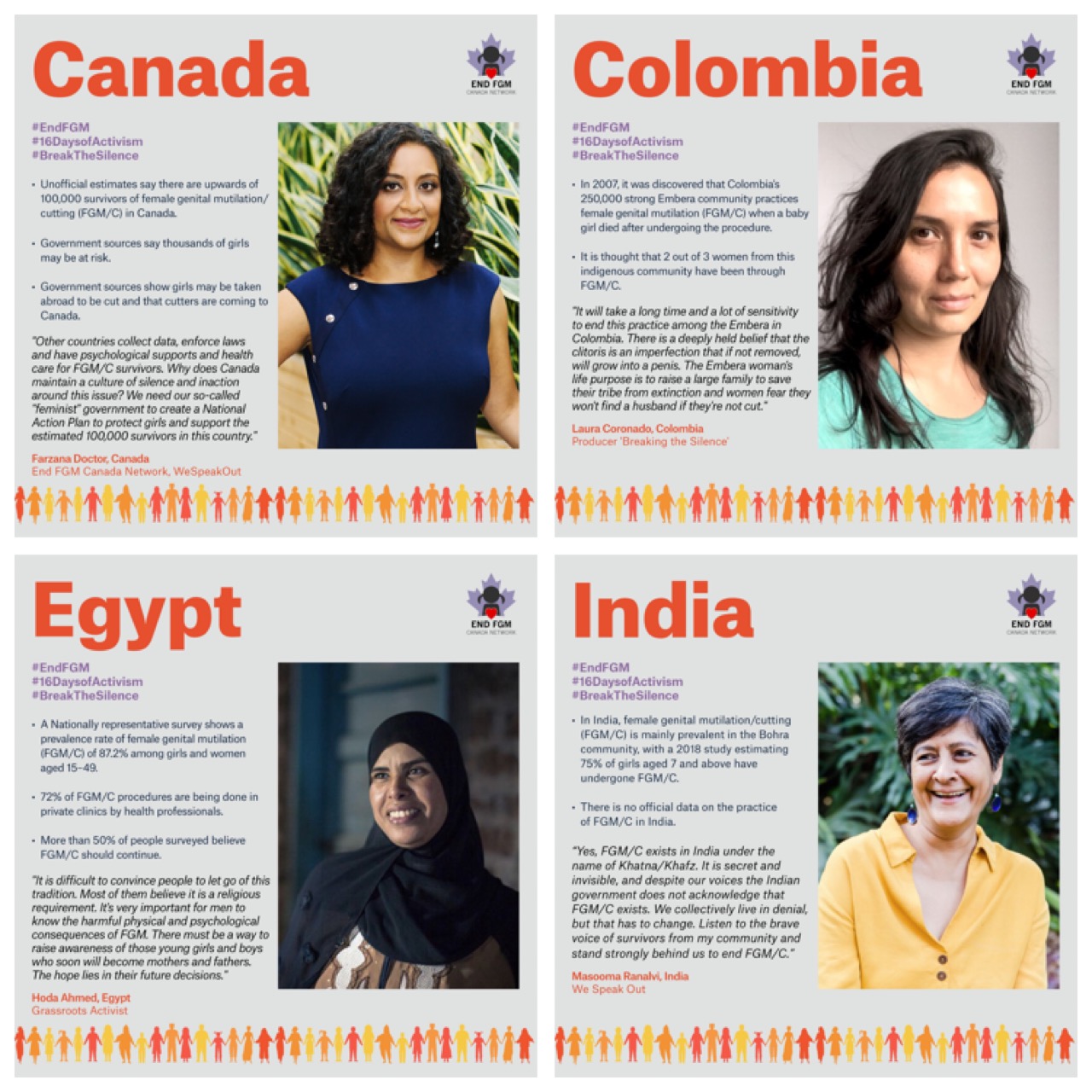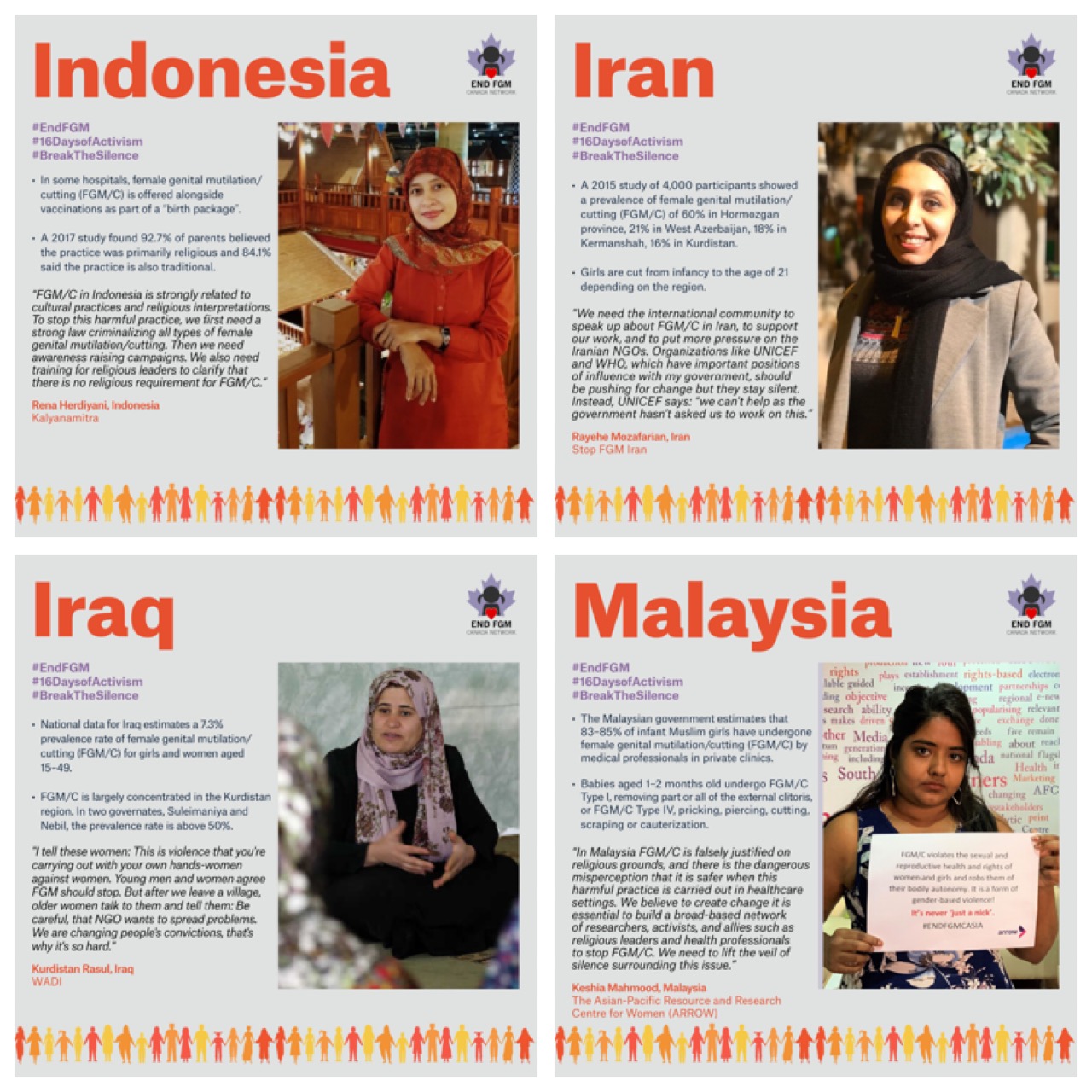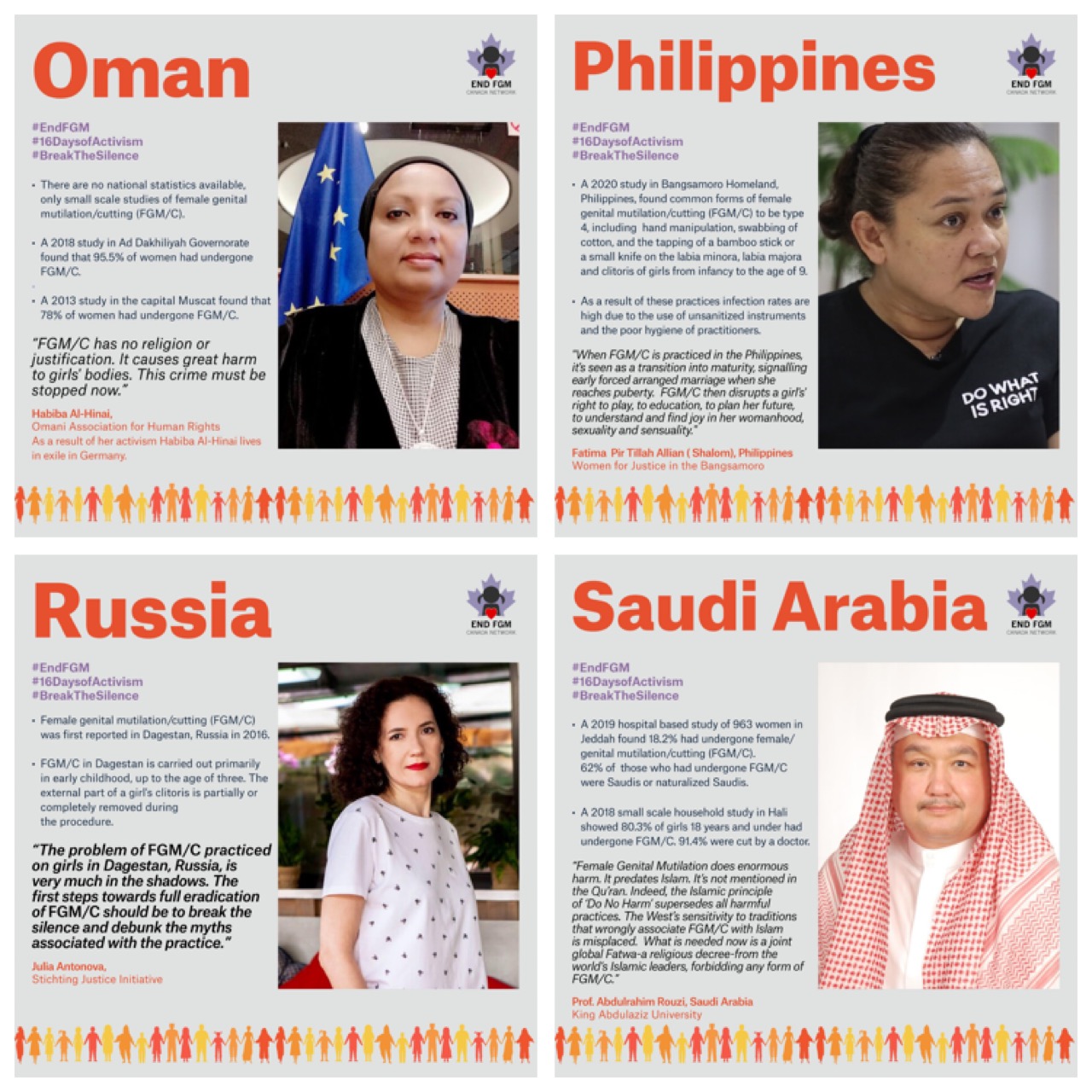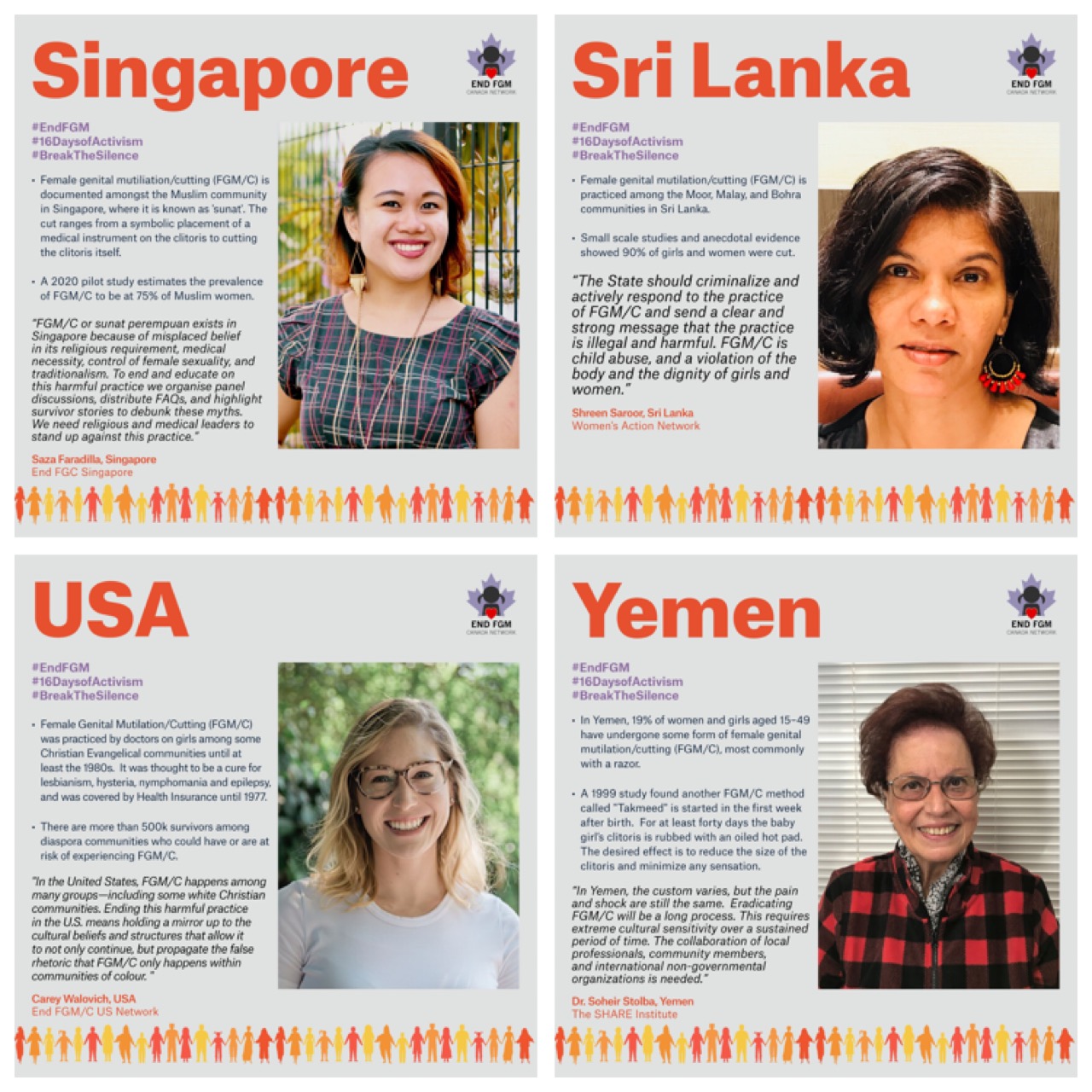The EndFGM Canada Network used the 2020 16 Days of Activism against Gender-Based Violence as an opportunity to shine light on the lesser known places where FGM is happening.
Your silence will not protect you. ~ Audre Lorde
Here are some summaries of the situation in Canada, Columbia, Egypt, India, Indonesia, Iran, Iraq, Malaysia, Oman, Philippines, Russia, Saudia Arabia, Singapore, Sri Lanka, United States of America and Yemen.
 |
 |
 |
 |
(Infographics courtesy of EndFGM Canada)
Canada
- Type of FGM: Type 1 or 3, dependent on different communities (Type 1 across India, Pakistan and within the global diaspora and Type 3 in the Canadian-Somali community);
- Prevalence: unknown;
- Well-known Candadian activists are Giselle Pontenier (the filmmaker of In the Name of Your Daughter), Farzana Doctor (author of Seven) and Maryam Sheikh.
Colombia
- Type of FGM: Type 1;
- Prevalence: it is practiced in the Emberá communities, but there are no reliable statistics on how many girls are affected; the Colombian National Indigenous Organization (ONIC) estimates that two out of three Emberá women have been cut, according to 2012 estimates;
- Read the personal story of Solani Zapata.
Egypt
- Type of FGM: Types 1 and 2;
- Prevalence: the estimated prevalence is 87.2% among all women aged 15–49, which means, with a nearly 100 million, that Egypt has the greatest number of women and girls who have experienced FGM of any country in the world; the practice has been illegal since 1996.
- The medicalization of FGM is a signifcant issue; 79% of girls aged 0–17 year have been cut by a health porfessional.
India
- Type of FGM: Type 1;
- Prevalence: it is most practiced in the Bohra community; there is no accurate data available on the prevalence;
- Masooma Ranalvi is a very well known Indian activist; it is worth reading more about her.
Indonesia
- Type of FGM: Types 1 and 4;
- Prevalence: the practice of female khitan or sunat perempuan is so common that maternity clinics offer the procedure as part of a birth delivery package, done soon after labor without additional charges; it is estimated to have been done on 60 million women, or half of the women in Indonesia.
Iran
- Type of FGM: Types 1 and 2, depending on the village; there are reports of Type 3 being practiced in Khuzestan province;
- Prevalence: varies across the country from 15–60%.
Iraq
- Type of FGM: Type 1;
- Prevalence: it was difficult to get reasonably accurate information on prevalence, but it seems that the practice is on the decline in the country; the British Home Office shared the following data: FGM mainly occurs in the Iraqi Kurdistan Region (IKR), concentrated in the governorates of Erbil and Sulaymaniyah, with a prevalence rate in women and girls aged between 15–49 at 46.6% and 45.6% in each governorate, respectively. Sources state that FGM also occurs in Dohuk, but at very low levels, with a 2017 study of 5990 people carried out by the Heartland Alliance showing that 7.4% of mothers of girls aged 4 to 14 had been cut, with only 4.1% of their daughters having undergone FGM. Sources state that prevalence and support for FGM is higher in rural areas among people with lower levels of education
- Read the amazing story of Kurdistan Arul here.
Malaysia
- Type of FGM: Type 1 or 4 (needle prick to the clitoral hood) and typically done on female babies as young as one or two months old;
- Prevalence: 83–85%, perhaps even higher; a study done in 2018 shows a strong trend toward the medicalization of FGM.
Oman
- Types of FGM: Types 1 and 2;
- Prevalence: it is estimated that 95.5% of women and girls in the country have been cut;
- A change to the legislation was put in place during 2019.
Philippines
- Type of FGM practiced: Type 4; however, it is very different from the Type 4 practiced in other countries, as explained here, and is regarded as a rite of passage;
- Prevalence: unknown.
Russia
- It was first reported in 2016 in the province of Dagestan;
- The first criminal investigation only took place June 2019, when a father took his daughter to be cut; both the father and the gynecologist who did the procedure are under trial;
- Type of FGM practiced: Type 1;
- Prevalence: unknown.
Saudi Arabia
- Type of FGM: Types 1, 2, 3 and 4;
- Prevalence: it is difficult to give an accurate number: a small-scale study done in 2018 revealed a prevalence of more than 80% in girls younger than eighteen years, with more than 90% done by a physcian. A 2019 hospital study found that more than 18% of women have been cut. The feedback from this study was ‟We knew women and girls were being cut in Saudi Arabia, but not to such a large extent.”
Singapore
- Type of FGM: Type 4 (also known as Sunat Perempuan in Malay), usually done before the age of two years;
- Prevalence: it is estimated that 60% of the female Muslim population has been cut.
Sri Lanka
- Type of FGM: Type 1;
- Prevalence: small-scale studies show that up to 90% of girls will go though FGM by day 40 of their lives;
- The interview with a cutter provides a rare insight into the lives of cutters.
United States of America
- Type of FGM: Types 1–4, dependent on the community
- Prevalence: uncertain; the CDC estimated that there are approximately 500,000 girls and women living with FGM (this is regarded as a very inaccurate number);
- FGM was considered a standard medical procedure in America for most of the nineteenth and twentieth centuries and was used as treatment for lesbianism, masturbation, depression, hysteria and nymphomania until the 1970s.
- Kentucky FGM Survivor: “…through Kentucky passing the law, my chains are broken and I feel free.”
Yemen
- Type of FGM: Type 1 or 4 (rubbing the clitoris with a hot oil pad with the aim of reducing the size of the clitoris);
- Prevalence: there is very little data available, but it is estimated that the prevalence of FGM is <20% of women and girls.
